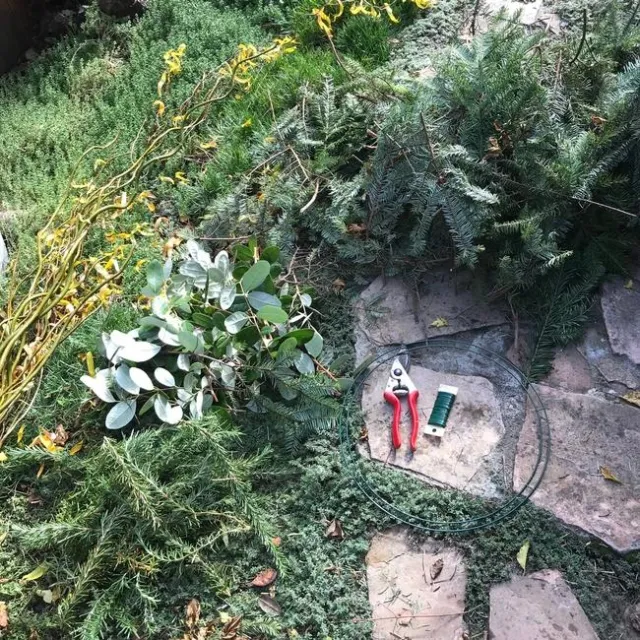I just finished the last of my wrapping for out-of-state packages. Hopefully, I can make my wreath today after I finish the rough draft of this blog. I really miss being able to volunteer in the annual Master Gardener Wreath Workshop. This makes the second year that we have not been able to offer one due to Covid. I miss the harvesting of the redwood boughs. Then there is the cutting down of these boughs and other evergreens that Master Gardeners bring from home. Once cut into wreath size pieces, they are then soaked in water, drained, and boxed up.
On the big day itself, we got to help people make beautiful, unique creations with the greens we supplied. Then they chose bows and decorations to adorn their wreaths. The hustle-bustle, the scent of the evergreens, and sharing in the creative spirit were always a wonderful way to start the holiday season off.
But this year I will be using mywireframe from previous years and working on my own at home. I saved the boughs cut from the bottom of my Christmas tree and extra branches that the tree lot people said I could take. They have been lying on the ground outside for about a week but with the moist overcast days we have had, I think they will be fine. I plan to add some rosemary that I will clip today and possibly pineapple guava, and curly willow branches.

We have found that cutting branches into 12–18-inch pieces seems to work best in wreath making. I'll try and soak the freshly cut greens in water for 20 minutes before I start actually putting the wreath together. Paddle wire needs to be attached to the wreath form. Next clusters of greenery are attached to the frame with the paddle wire, overlapping the bundles until you have covered the whole frame. How close together you place the bundles affects how full your wreath will be. If you don't have enough greenery or branches to make a complete wreath you might want to consider adding things from your garden to a purchased wreath, it can really liven it up.
Now it's time for decorations. These can vary from pinecones, berries, fruit, dried seed heads, dried flowers, dried citrus slices, succulents, or even fresh flowers in water-filled spikes. Ornaments, small toys, and lights can also be used. Attaching the decorations depends on the size and weight of the piece. Some can be hot glued, others wired or put on picks. And lastly the decision about the bow. What color ribbon? What size bow? Is this the year to go without?
The tradition of wreaths or circular gatherings of plant materials goes way back in human history. According to the Britannica website, Egyptians would sew flowers to linear bands of linen and tie them around their heads. In ancient Greece wreaths made of leaves were used to crown victorious athletes, poets, and speakers. Laurel and olive were favorite choices.
Evergreen boughs were used in many cultures to celebrate the winter solstice. Because they retained their leaves throughout harsh winters, they were a symbol of resilience and strength. The circular shape of wreaths is also a symbol of everlasting life. Hanging these wreaths and boughs was thought to bring protection and good luck. A post on Hort, the online site of the Horticultural Society of New York, by Margaret Riche, explained that in early Celtic culture, particularly in Ireland, fairies were thought to take shelter on the undersides of holly leaves. Therefore, fairies would be kinder to people who hung holly branches on their houses.
When Christianity spread to Europe, the religious leaders gradually adopted these traditions and used them to celebrate the birth of Christ. The season of Advent features a large wreath with four candles lit consecutively on the Sundays before Christmas. Many churches hang wreaths or evergreen garlands in their sanctuaries. Some even have evergreen trees decorated with religious symbols.
In modern times, wreaths are hung on doors, fences, and walls throughout the year. For different seasons different materials can be used. In spring and summer, flowering branches and vines are available. Grapevine wreaths are beautiful anytime. Of course, wreaths can be made of inorganic materials as well: a coiled and decorated garden hose, layered garden gloves, miniature flags, handkerchiefs, corks. The list goes on and on.
I really enjoyed putting the wreath together today. It wasn't as much fun as the Wreath Workshop but it was still fun. I will decorate it tomorrow.

